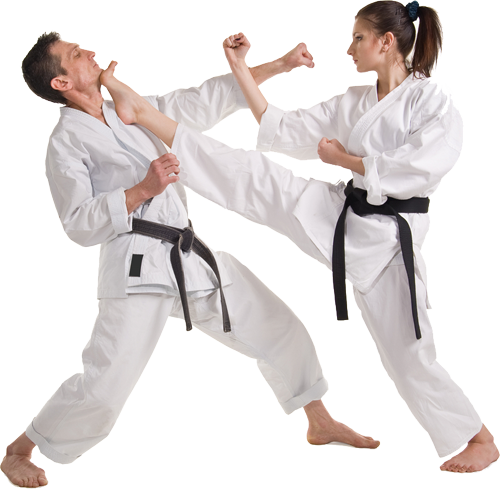Karate: The Way of the Empty Hand

Karate is a martial art discipline that involves kicking, striking, and defensive blocking. It is practiced as an art (budo), self-defense and a sport.
Originating from Japan, Karate was founded by Gichin Funakoshi in 1902. Karate means empty hand. Although empty-handed techniques are practiced most of the time, occasionally weapons are practiced as well. A Karate practitioner is called a Karateka. Famous practitioners include Jean-Claude Van Damme, Jennifer Aniston, Luca Valdesi, Bill (superfoot) Wallace.
History
There are no formal records of the early roots of karate. Different fighting techniques were practiced in the Ryukyu islands of Japan and it is assumed that these techniques were influenced by Chinese martial arts (Kung fu). With time, some Ryukyuan families moved to Okinawa and the fighting systems started to spread. In 1609, there was an invasion of Okinawa and its inhabitants were banned from owning any sort of weapons or practice fighting techniques. This directly impacted the development of Karate.
In 1875, Okinawa officially became a part of Japan and the ban was lifted. Soon the art started to spread across Japan. And finally, in 1902, Gichin Funakoshi gave Karate its official form. And from there, Karate started to spread rapidly around the world.
Styles
Although Gichin Funakoshi is credited to be the founder of Karate, many other practitioners taught Karate in their own flavor. This gave rise to different dialects of Karate. Only four styles of Karate are officially recognized by The World Karate Federation (WKF). There are more than 10 other unofficial styles that exist.
Official styles
Styles recognized by WKF-
- Shotokan
- Goju-Ryu
- Shito-Ryu
- Wado-Ryu
Shotokan is the most popular style of Karate (founded by Gichin Funakoshi).
Unofficial styles
Among the unofficial styles, these are the most popular ones-
- Kyokushin (most popular)
- Isshin-Ryu
- Uechi-Ryu
- Shorin-Ryu
Practice
A Karate practice place is called Dojo. There are two main aspects of Karate- Kata and Kumite. Kata literally means “shape” or “model.” It is a formalized sequence of movements which represent various offensive and defensive postures. It can be performed alone or in groups. Check out this amazing kid performing Kankudai kata!
The other aspect, Kumite, literally means “meeting of hands.” It is just the Japanese name for sparring. The introductory video contains an Olympic Kumite that you can watch. There are a lot of techniques used in Kumite. Unless you are really interested to know the name of techniques, you may skip the following.
Kicks
- Mae Geri (front kick)
- Yoko Geri (side kick)
- Mawashi Geri (roundhouse kick)
- Ushiro Geri (back kick)
Hand strikes
- Oi Tsuki (front punch)
- Gyaku Tsuki (alternate punch)
- Yoko Enpi (round elbow strike)
- Mawashi Enpi (side elbow strike)
- Nukite (finger strike)
Blocks
- Age Uke
- Uchi Uke
- Sotto Uke
- Gedam Barai
- Shitto Uke
Ranking
Karate students wear belts of different colors (called Obi) which determine their rank. The belt system in Karate is adapted from Judo. There are 10 levels of colored belts (Kyu) and 10 levels of black belts (Dan). To get promoted to the next rank, a student has to acquire a certain skill level and pass an exam. The exams are usually taken in an interval of 3-4 months.
White - 10th Kyu
Yellow - 9th Kyu
Orange - 8th Kyu
Red - 7th Kyu
Green - 6th Kyu
Purple - 5th Kyu
Blue - 4th Kyu
Brown(1) - 3rd Kyu
Brown(2) - 2nd Kyu
Brown(3) - 1st Kyu
Black - 1st Dan to 10th Dan
Not all dojos follow the exact ranking. Some dojos may add or omit some colored belts.
Personal opinion
Karate is the most natural martial art. What I mean by natural is that there are arts, that have stances, punches, and kicks that do not come naturally. In Karate, the movements, strikes, and kicks are simple, natural and comes intuitively.
Karate is also a very well rounded martial art. It focuses on weaponizing every part of the body equally. Taekwondo focuses mostly on legs, and Judo is all about throws. There is nothing like this in Karate. Punches, kicks, throws, and all other aspects have equal value.
Although Karate emerged for the need of fighting in practical situations its effectiveness in self defense is decreasing gradually. That’s because it has become more of a sport than an art of fighting. If you want to learn self-defense then Karate will not be worth the effort. Of course, this has exceptions and there are some gyms will that will truly teach self-defense. But in most places, you will be taught how effectively you should punch to get a point.
Despite questioning its effectiveness, Karate is a very beautiful and fun art to learn. There is no reason why one should not enjoy Karate. It is very easy and beginner-friendly. The learning curve, in the beginning, is not so steep as other martial arts. If you want to learn a martial art for fun or physical exercise, you can definitely consider Karate.
Sharing is caring!